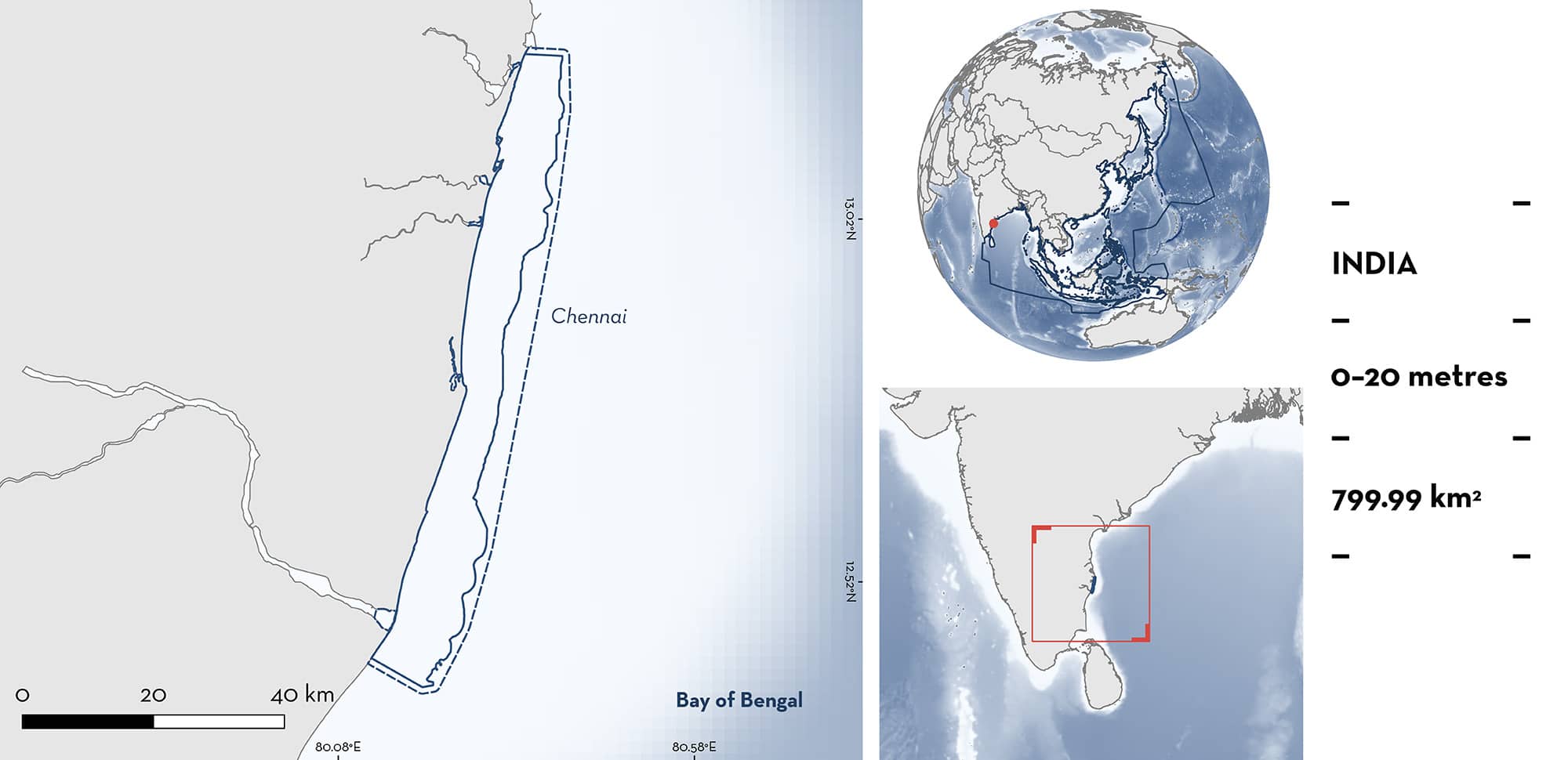ISRA FACTSHEETS
ISRA FACTSHEETS
ASIA REGION
Chennai
Summary
Chennai is situated off the east coast of India. The area is characterised by substrates that comprise sand and clay-sand. It is influenced by a monsoonal climate with coastal upwelling increasing productivity. Within this area there are: threatened species (e.g., Smoothback Guitarfish Rhinobatos lionotus); range-restricted species (e.g., Shorttail Whipray Maculabatis bineeshi); and reproductive areas (e.g., Brown Numbfish Narcine timlei).
Download factsheet
Chennai
DESCRIPTION OF HABITAT
Chennai is situated along the east coast of India off Chennai. The area is characterised by substrates that comprise sand and clay-sand (Veerasingam et al. 2014).
Chennai is influenced by a monsoonal climate with the southwest monsoon occurring June–September and the northeast monsoon October–November. Coastal upwelling results in phytoplankton blooms which support large zooplankton populations along with larger marine organisms (Bakun et al. 2015). Coastal upwelling signatures have been identified along the stretch of the coast between Chennai and Vishakapatnam based on satellite sea surface temperature data (Muni Krisna 2008).
This Important Shark and Ray Area is benthopelagic and is delineated from inshore and surface waters (0 m) to 20 m based on the bathymetry of the area.
CRITERION A
VULNERABILITY
Three Qualifying Species considered threatened with extinction according to the IUCN Red List of Threatened Species regularly occur in the area. These are the Critically Endangered Shorttail Whipray (Sherman et al. 2021) and Smoothback Guitarfish (Dulvy et al. 2021), and the Vulnerable Brown Numbfish (VanderWright et al. 2021).
CRITERION B
RANGE RESTRICTED
Chennai holds the regular presence of Shorttail Whipray and Smoothback Guitarfish as resident range-restricted species. These species occur year-round and are commonly caught as incidental catch in benthic set small-mesh gillnets in the local crab fisheries operating at depths to 20 m in the area (Ida et al. 2023; Moumita D unpubl. data 2024). The monitoring of landing sites between 2021–2023 show that Shorttail Whipray occurrence peaks in this area during November–April (Bineesh KK unpubl. data 2021–2023). Examined landings during this period showed the regular presence of adult females (n = 46; 21–34 cm disc width [DW]), adult males (n = 62; 21–41 cm DW), and juveniles (n = 15; 17–26 cm DW). Higher numbers of both juveniles and adults were observed in the catches landed at Chennai compared to catches at another monitored landing site at Kanyakumari, Tamil Nadu (Bineesh KK unpubl. data 2024). Smoothback Guitarfish are present year-round and examined landings during 2021–2023 showed the regular presence of adult females (n = 112; 36–72 cm total length [TL]) and adult males (n = 60; 33–68 cm TL) (Bineesh KK unpubl. data 2021–2023). Chennai represents the area where Smoothback Guitarfish are most regularly encountered in India (Bineesh KK unpubl. data 2021–2023), for example one study looking at the distribution of guitarfishes collected 75% of Smoothback Guitarfish samples at Pattinapakkam fish landing site adjacent to Chennai (Ida et al. 2023; Bineesh KK unpubl. data 2024). These species occur in the Bay of Bengal Large Marine Ecosystem (LME) and Arabian Sea LME.
CRITERION C
SUB-CRITERION C1 – REPRODUCTIVE AREAS
Chennai is an important reproductive area for one ray species.
Data collected from fisheries monitoring surveys at Pattinapakkam fish landing site, from boats operating in the Chennai area indicate that Brown Numbfish are a regular incidental catch of benthic crab gillnets operating to 20 m depth. During monitoring of this landing site from August 2022 to September 2023, a total of 956 individuals including 16 gravid females (1.7% of individuals examined; primarily recorded December–March) with a size range of 15–16 cm total length (TL), 68 neonates (7.1%) of 4.0–4.6 cm TL, and 122 young-of-the-year (YOY) (12.8%) of 5.1–6.4 cm TL were observed in the catch (Moumita D unpubl. data 2024). Early life-stages were classified as neonates if internal yolk sacs were visible and YOY if these were not visible, but the size was close to that reported as the size-at-birth in the literature (~6 cm TL; Last et al. 2016). Interviews with crab fishers during visits to the landing site from 2021 to 2024 indicate that pregnant Brown Numbfish are a common bycatch in the fishery with fishers commenting that they observe females aborting pups when entangled in the nets (Moumita D unpubl. data 2024). This confirms the regular occurrence of reproductive activities in the area. Furthermore, Chennai is the only area in the world where reproductive activities have been documented with the only available literature describing reproductive biology in Brown Numbfish from Chennai (Devadoss 1998).
Download factsheet
SUBMIT A REQUEST
ISRA SPATIAL LAYER REQUEST
To make a request to download the ISRA Layer in either a GIS compatible Shapefile (.shp) or Google Earth compatible Keyhole Markup Language Zipped file (.kmz) please complete the following form. We will review your request and send the download details to you. We will endeavor to send you the requested files as soon as we can. However, please note that this is not an automated process, and before requests are responded to, they undergo internal review and authorization. As such, requests normally take 5–10 working days to process.
Should you have questions about the data or process, please do not hesitate to contact us.


